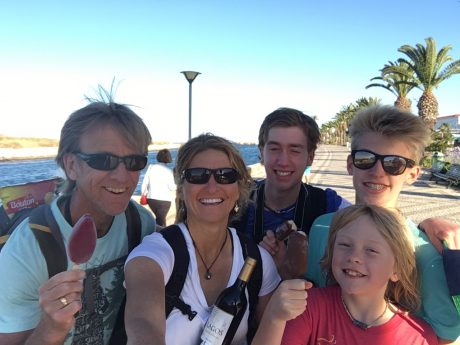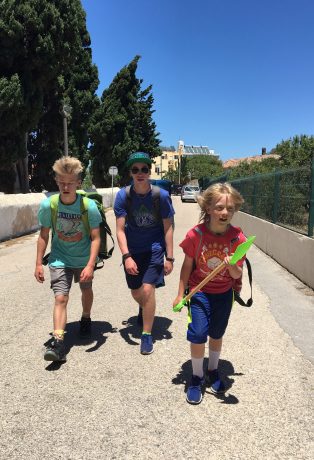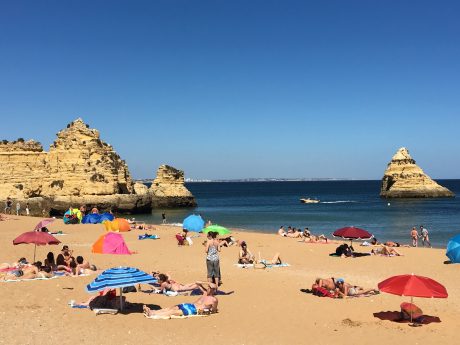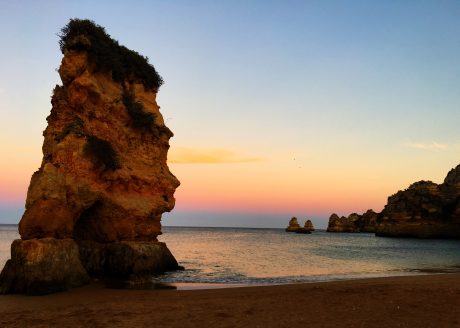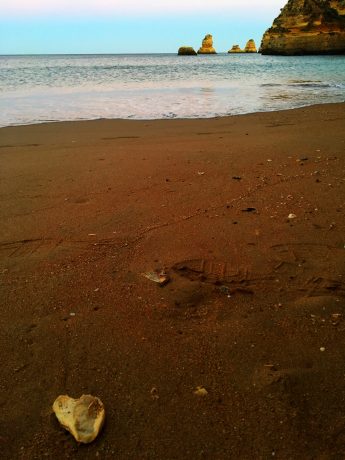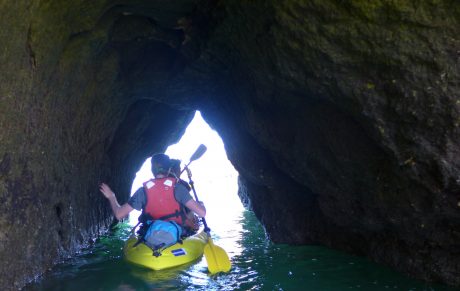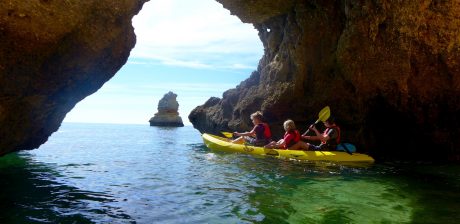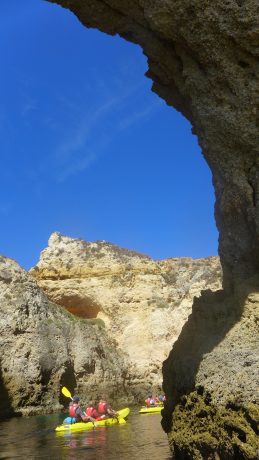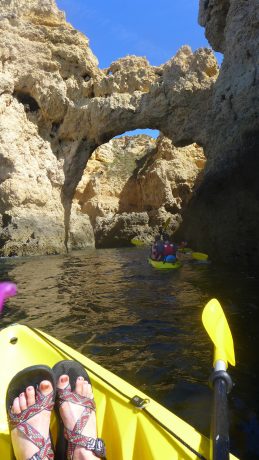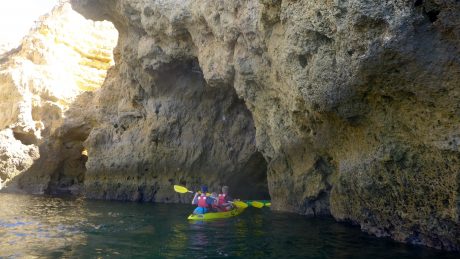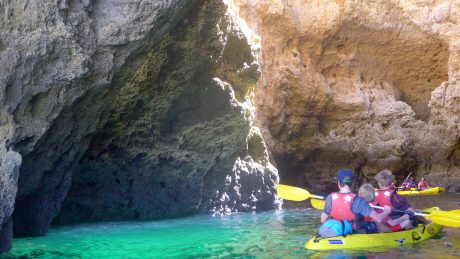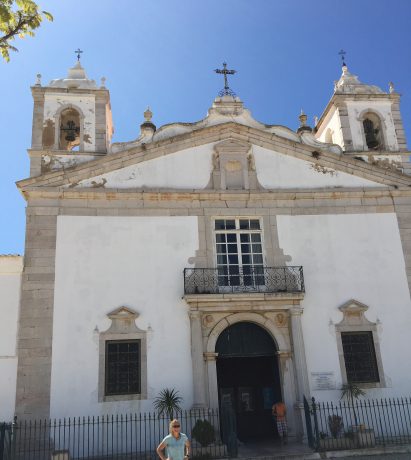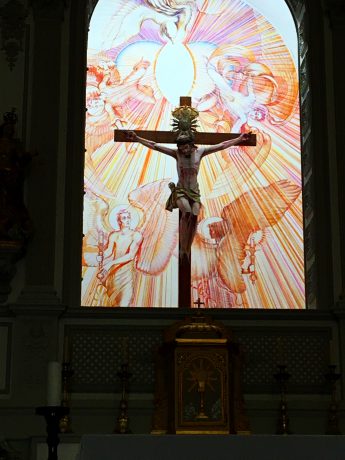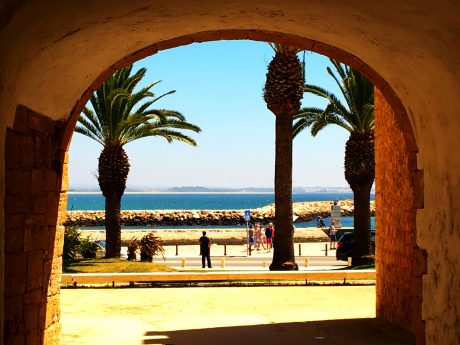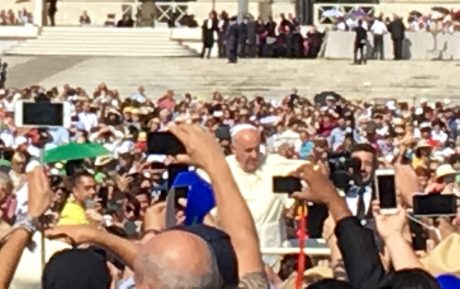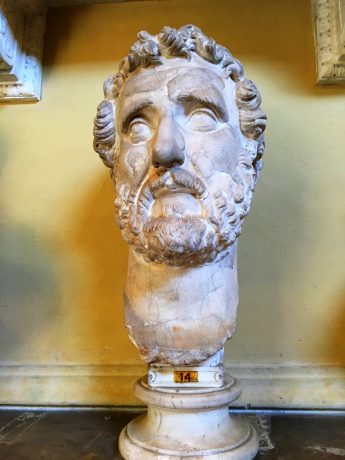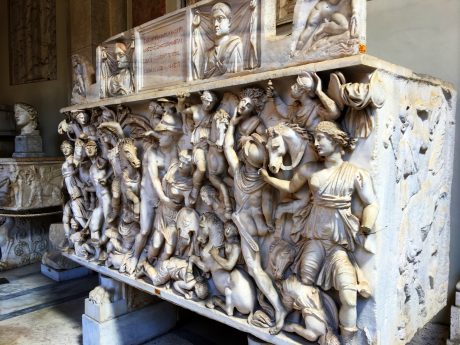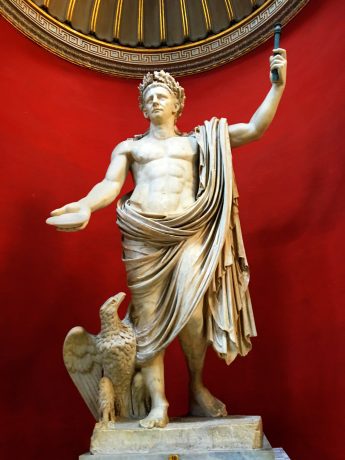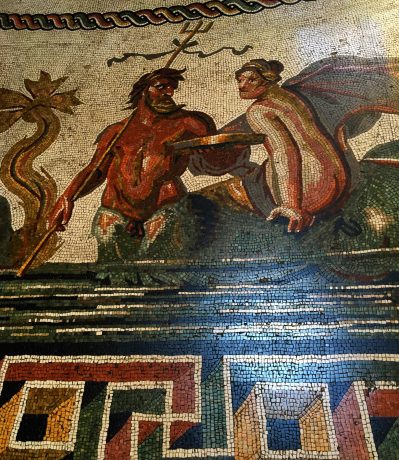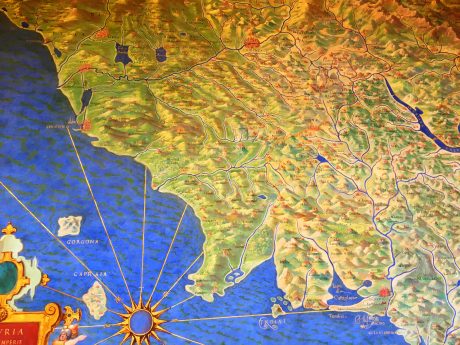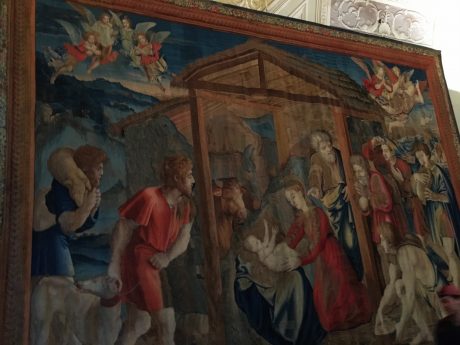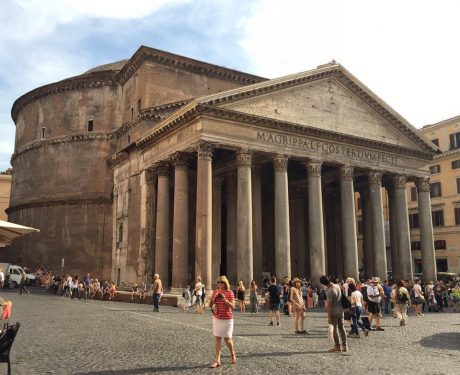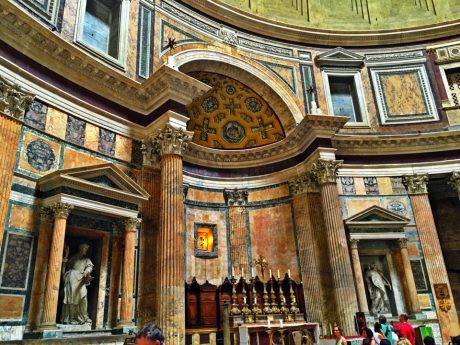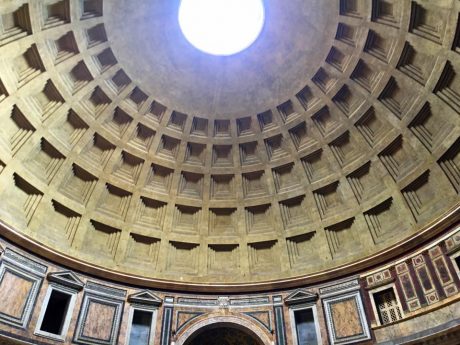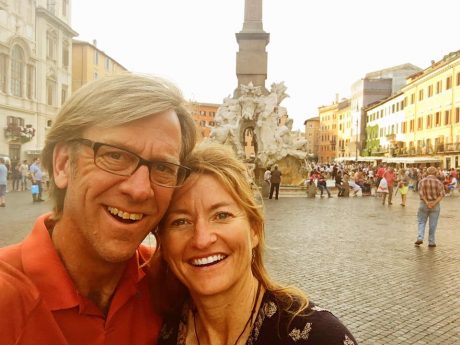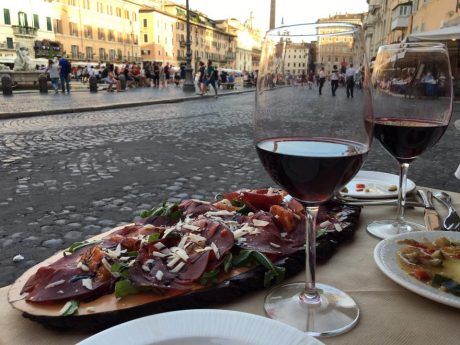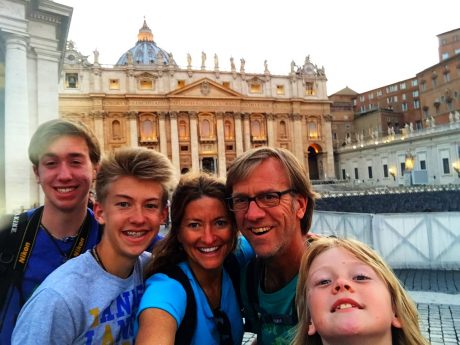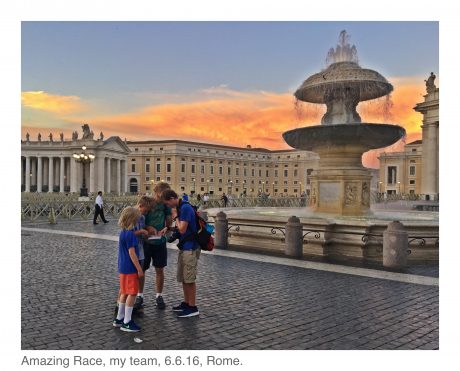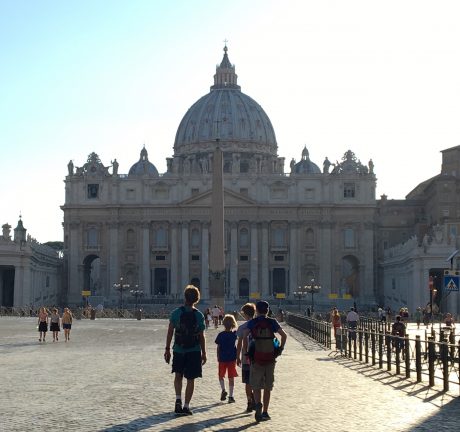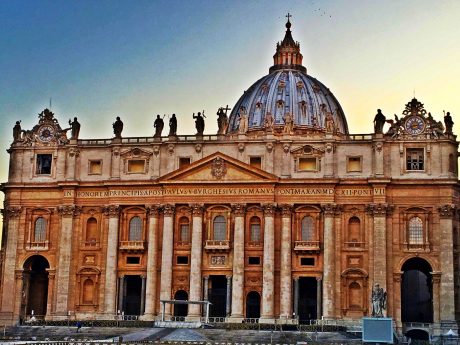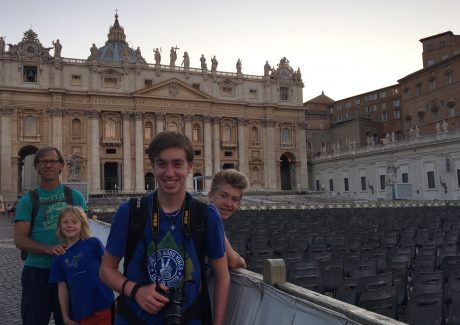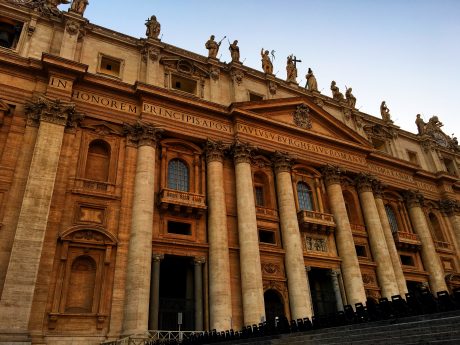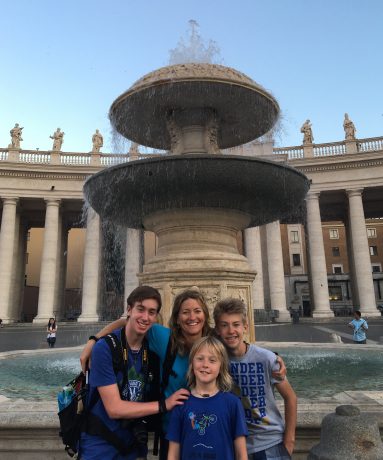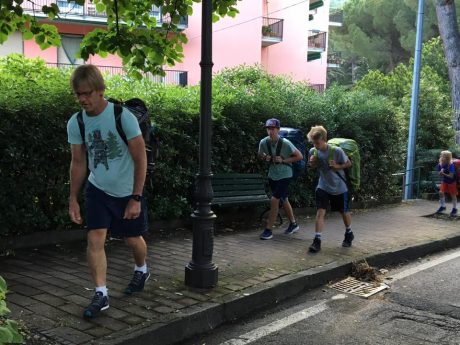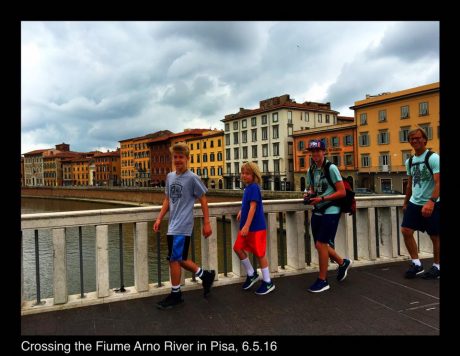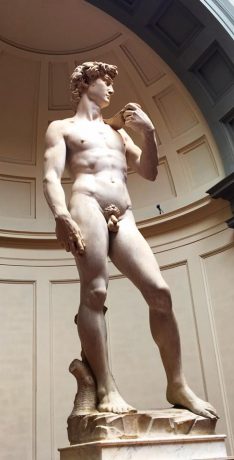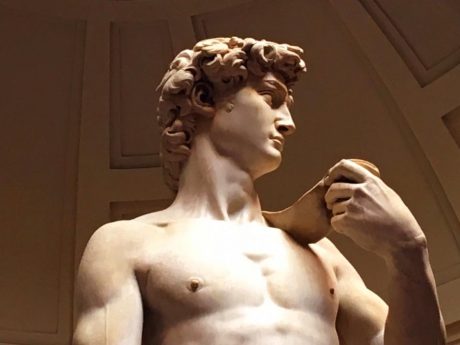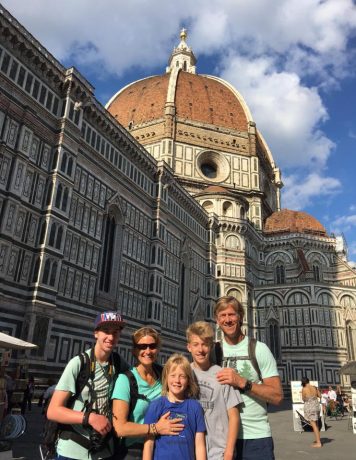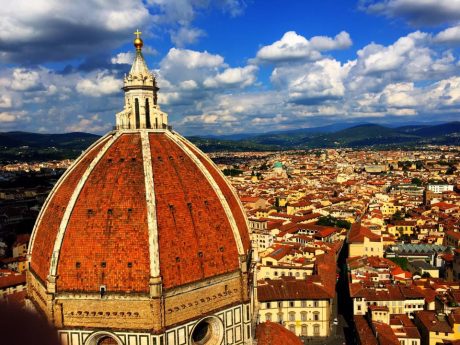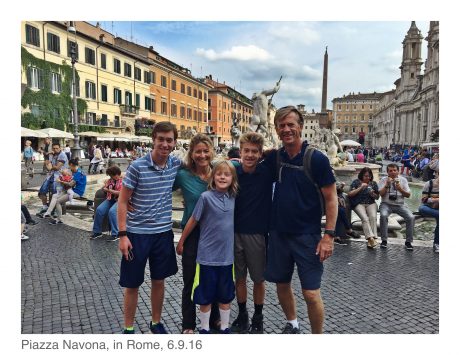
Greetings from 30,000’ in the air, somewhere above England. We are just starting our long flight back to the United States. Our hard-earned, dream-come-true Epic Family Europe Adventure is coming to an end. It’s been an unforgettable experience, and one that has impacted us in so many ways. (I’m adding this sentence on Sunday, June 19: As we drove into our small town of Lander, Wyoming, a charming town in the foothills of the Wind River Range that is home to just 7,000 people, one of our sons remarked from the backseat, “It’s so great to be here. It’s the same, but somehow it feels different.” This says it all, really. We are changed because of all that we have seen and experienced and learned that was new and different.)
During our great adventure, we kept a family journal. At the end of every single day, we each contributed our thoughts about what was special or noteworthy about the day’s events, and what we’d like to have on record. (I’ve also blogged throughout this great adventure. In fact, this is my 15th blog post. If you’re interested, all previous trip reports from this Epic Family Adventure include are listed and linked to at the bottom of this blog post.)
Today, as we sat in Heathrow for two hours waiting to board this flight, we all shared with each other takeaways and observations we are taking home with us from this experience. They are numerous. I’m including them below. First I’m listing mine, and then I’m going to include some of the notes from Jerry and the boys. I hope you enjoy!
Takeaways and/or observations from our 29-Day Epic Europe Family Adventure:
• I still love my family! In fact, I love them more today than I have ever loved them. Before this trip, we were a close family. By design, we have a pretty simple life, and we spend a lot of time together. We just finished spending almost every single moment of every single day for 29 days together, sometimes in tight quarters. We traveled on trains together, buses and planes. We were packed together like sardines on many subway rides. Some of our apartments and flats were quite small. We did everything together. I was expecting that our relationships with one another, and as a family would be enriched, but also that there’d be a lot of arguing. There was even more enrichment than I expected, and less arguing than I expected. I have made new discoveries about each of our sons, and my husband. The togetherness we have experienced, combined with the fact we got to discover and see so many new sights together was priceless. Sharing this type of adventure as a family is in itself a reason to make a trip like this happen!
• We are very lucky in the U.S. We have it so good in so many ways. I believed we had it great in many ways, but now I know it firsthand. For one thing, our restrooms. We have them everywhere, and they are for the most part clean, and free. True, sometimes we buy a candy bar or pack of gum at a convenience store in order to use the restroom, but we don’t have to pay an attendant $1 to use the bathroom, or wait in long lines to use them, and compared to Europe, they’re abundant.
• Kindness is a universal language, and it matters a lot. In so many countries, we didn’t speak the language, and were able to get by with kindness, and knowing how to say Please, Thank you and I’m sorry in the native language. Smiling and showing appreciation is important, and goes a long way when traveling to foreign countries.
• I love wine. I loved red wine before this trip. Now I love it even more. In Italy, I became accustomed to drinking red wine on a very regular basis. And Portugal had inexpensive, delicious wine. It was the good life – shall I say, La Dolce Vita. (After my 16-day NOLS course in Alaska in 2011, upon my return, I had to learn how not to yell bear calls. We had to make bear calls so often. After this Europe trip, I will have to learn how to not drink wine every single afternoon and evening!)
• We need to walk to places more often. We logged, on average (and including our rest and travel days), 24,500 steps (10-11 miles) a day. We walked everywhere, and, except for the hikes from train station to apartment in each new destination, when we had our big duffel backpacks on, no one complained! It was just our way of life. We saw more, had more freedom and independence, and slept better each night. We all agreed that we ought to walk to more places in Lander. (The boys related how walking to Mr. D’s for donuts is only 1,500 steps. Considering our 24,500 steps/day average, this seems pretty reasonable!)
• Related to the previous takeaway… when you’re fit you get to see a lot more of a place. We had no problem walking from morning ’til night, and as a result we saw more and experienced more than if we were not fit, AND we slept better each night.
• For 29 days, we watched no television, and followed no news. I didn’t miss it – the bad news, especially all the Trump stuff.
• I loved being exposed to so much diversity. The people we met in each of the cultures we experienced were unique and different, fascinating and wonderful. The people watching, also, was remarkable and part of experiencing each place. While every area we toured had lots of diversity, we noticed it especially in London, where reportedly more than 300 languages are spoken.
• You can’t experience a culture without eating its foods. I love food. At home, by choice, I live with a lot of food restrictions, and am very disciplined. I indulge, but only occasionally. For this trip, I wanted to fully immerse myself in the experience, and that includes all of the delicious foods. What a treat! I loved the attention put into the food and wines and desserts, and the experience of slowly eating and enjoying consuming it. Italy, in particular, influenced me. They are laid back, and take their time at cooking foods, and gathering to enjoy it, always with lots of family and friends around. As our oldest son put it so perfectly: “Tasting and enjoying food, and just eating food quickly are not the same thing.”
• At least in our experience, with relative ease, in Europe, trains can get you anywhere you want to go. We explored destinations in 7 countries, almost all by trains. And the Underground in London is nothing short of remarkable. We could go anywhere using the subway, and always be somewhere even if we made a wrong connection. (By the way, Jerry is nothing short of a Hero. He deserves ALL of the credit for navigating and successfully orienteering us throughout 7 countries in Europe. He was responsible for figuring out our Rail pass, and all of our train connections. There were 100, give or take, train connections in all, and we made all of them thanks to Jerry!)
• Rome is my new favorite city. All of the Piazzas, the old age and remnants of a time that was thousands of years ago, the statues and fountains, and little restaurants, the street performers and gelato, vino and food… We had some really meaningful walks and evenings in Rome, not to mention all of the sights we explored at a very deep level.
• Germany was raucous, fun, festive and “on time.” We loved it, and immersed ourselves in the beer gardens, the way of life, the scenery of the Bavarian Alps, Marienplatz, outdoor markets, etc.
• Restaurants in Italy and Portugal are small and very personal. Some felt like you were eating in someone’s house, and the service & pride in their food were exceptional. And, I like that they tried to earn your business. Outside most restaurants was someone with a menu trying to convince you to eat at their place. This was not obnoxious selling, but rather prideful inviting, and there is a difference.
• It is hard on your feet to walk so many steps and miles on marble and granite and cobbled tile streets! I don’t want to complain, but the feet protested quite a lot at the end of the day. But I wouldn’t trade the experience for anything, and walking on marble floors and tiled streets was temporary. There are not a lot of those surfaces in our beloved Wyoming!
• Sometimes in the hiking world we call them trail angels – someone you meet on the trail who is helpful. We met some real angels on our trip. These were people who appeared as if out of nowhere to offer help when we needed it. (We had to disembark a train in Paris, and find another train station to find our next connection, all in a very short time period. We didn’t speak French, and this was a lot of pressure to try to get help and find the train station. We were struggling and wandering a little aimlessly outside of the train station, when a father who was pushing his daughter in a stroller approached us out of nowhere and asked if he could help us. This happened again in Monterossa, Italy, when a German man & woman showed us the way to an alternative trail once we learned the Cinque Terre Trail was closed. We had another angel in the form of an elderly lady in the Lagos, Portugal train station. These experiences cause me to love humanity even more, and have inspired me to pay it forward.
• Our boys were eating us out of house & home BEFORE this trip… With all the good food everywhere this was going to potentially be a problem for our budget in Europe, and indeed, by Day 12, we were way over budget when it came to food. (Usually our vacations are a week long, and managing a food budget for a family that includes growing boys isn’t an issue. But for a 30-day trip, managing the food budget was critical, and we didn’t start out doing very well. Add to this the boys were asking for food constantly. I am not exaggerating, and I was beginning to get depressed having to say No so often! You would have thought we weren’t letting them indulge at all, and we were saying Yes a lot, contrary to their continued asking for things. Switzerland, in particular, broke the bank. So, our solution? We decided to delegate the daily food budget management to our sons – or, specifically to our middle son, Hayden. We all chose Hayden because, of the three boys, it is well-established that is he is the saver of money. Once we gave Hayden the budget, he did a great job of keeping us on budget for the remainder of the trip, while still allowing them to indulge significantly. We even had some “2-gelato days!” This turning the budget over to one of our sons was a learning experience for all of the boys, and it was liberating for Jerry and I to turn over. (It was fascinating to see how Hayden strategized on all of our behalf, and to see how all of the boys became more miserly about what they asked for, and what they ultimately got once we explained that “money doesn’t grow on trees,” and that we had only a finite amount of it! Among other things, we observed the boys were willing to go longer between eating, and that they deliberated more when it came to ordering a small (1 scoop), medium (2 scoops) or large (3 scoops) gelato. Once they were in charge of gelatos, we ordered many more smalls and mediums! 🙂 We saw the boys often discussing, depending on the day and if we were in Italy or Portugal, if the bulk of money would be spent on dinner, or several treats throughout the day with just a pizza by the slice at night, vs. an entire pizza for each of them.)
• Before this trip, I had already been working hard to minimize and slow down on our accumulating of stuff. I definitely have a long way to go on this goal, as I’m quite a consumer. But this trip has made it more clear than ever that accumulating stuff is ridiculous. It costs money, requires space, and is not sustainable, not to mention it keeps us from spending our hard-earned money on ore important things – namely, experiences.
• When riding trains from one country to another, go to the bathroom before getting off train, so that you can use your short time while changing trains efficiently, and not have to pay to use the WC (Waste Control).
• Don’t be afraid to open a closed door. We discovered some really cool and beautiful places by daring to open a closed door. We were surprised every time by what was on the other side.
• Rainy days are sometimes welcome. The few rainy days we had made it possible – and even pleasurable – to do some laundry, to write, to read, to nap – to “chillax.”
• Always make the effort to see the sun set. We saw so many sunsets, and so many of them were extra meaningful. Our family likes to “chase the sunset” – race to a high place or to the edge of somewhere to get there right as the sun sets. We do this often in Wyoming, and on our adventures to national parks, etc. We chased sunsets upon arriving in Rome for the first time, and during our last night in Rome, and again upon our first arrival to Lisbon, Portugal. In Rome, after checking into our AirBnB, we hit the ground running toward the Sant ‘Angelo Bridge, and enjoyed seeing that wonderful sight for the first time, marveling at the beautiful statues of angels, as a harp player strummed a beautiful song in the background and the sun set. It was magical. Then, on our last night in Rome, we walked to St. Peter’s Square, with the fountain and Basilica in the background, our boys played fetch as the sun set behind them, and Jerry and I sat together and watched them. I had an overwhelming feeling of God’s presence, and have probably never felt so blessed. And, let me not forget to mention the sunsets in Rome’s Piazza Navonia, especially one night as the boys watched all of the street performers, and Jerry and I enjoyed a cheeseboard and wine tasting. Then, as we arrived at Lisbon, Portugal, for the first time we checked into our flat and then raced up several staircases and many maze-like and steep uphill, anciently-tiled narrow streets to reach the apt overlook, Ponta Del Sol, where we saw watched as the sun set and cast its angled light over the Tagus River. Other meaningful sunsets were on the beach in Lagos, Portugal, with Jerry after a romantic dinner date. Another was walking along the boardwalk above the Ligurian sea’s shoreline with the boys, as we ate gelato. Another was on the balcony of our flat in Moneglia, Italy, with the church bell ringing in the background. We also had unforgettable sunsets in Munich. As we returned to our flat each night in Munich, we watched men play chess in the park, and people gather on the beaches at sunset along the Isar River.
• Plan b can be as good as plan A. The Cinque Terre Trail was closed during our time in the area due to landslides from rains. At first this was a major bummer. Hiking the Cinque Terre Trail was something we were really looking forward to. But, thanks to a wonderful German couple we met, we discovered an alternative hike that was amazing in its own right. (From Monterossa to Levanto.)
• Do not hydrate when toilets are holes in the ground that are not kept clean. The worst toilet was the one at the Monterossa, Italy, train station. We were especially hydrated when in that area due to the hiking we had planned, and going to the bathroom, at least for me, was a problem. It was a hole in the ground, with no toilet paper available, and very gross and unclean that you had to wait in line for.
• As we expected, there are more nude sunbathers in Europe than in Wyoming. 🙂
• Italians are passionate. While in Italy, we often saw couples, in all age categories, kissing passionately.
• Tight, skinny jeans are everywhere in London, often considered the Fashion Capital of the World. After seeing so many people wearing these jeans, especially when I was in the hip and happening part of the city to give my presentation to leaders at the Sapient office, I wanted to wear some. Of course, I’ll have to work off all of the carbs first. 🙂
• We stayed in flats & apartments. Every time we’d arrive at a new destination, we’d load on our heavy Patagonia Black Hole Duffels/Backpacks and walk one half to one-and-one-half miles to find our AirBnB, flat or apartment. We all agreed that it was exciting and a little like unwrapping a present whenever we searched for our accommodations. In Rome, after struggling to find our flat, we finally found it. We had to pass through a door that was cut into an ancient bigger door, through a gate, and up one flight, two flight, and one flight more more, and through one more big green door to arrive at our surprise — a sprawling flat in a 17th Century building in central Rome. We learned from the flat’s owner that Gioachina Rossini, who composed the opera, The Barber of Seville, once lived in the flat!)
• We opted to stay in flats and apartments, and to avoid hotels, and that was an amazing plan. By staying in the central part of each destination, in an apartment or flat, we had more of a cultural immersion experience.
• I often feel insignificant with respect to the spectrum of time – for example, when I hike in Grand Canyon, which includes layers of rock that is billions of years old. But during this trip, it was more apparent than ever how short one life is. Particularly in Rome, where we stood on the floor of a home that was built in 64A.D., & walked the sacred street (date?), a 90-year life seems like less than a blip. By the way, words fall short in describing how it felt to stand, walk – and to touch – such ancient remnants, and to be transported so far back in time. It was nothing short of remarkable.
•Being open, flexible and unscheduled allows you to happen and stumble into things. We had many unexpected surprises as a result.
• That said, for a trip of a lifetime like this one, which was a significant investment of time and money, a certain amount of planning is critical to ensuring you have a trip of a lifetime. On the advice of some good friends who are world travelers we did schedule some private small group tours for particular attractions, such as the Neuschwanstein Castle, Vatican, Crypts and Catacombs and the Colosseum. These tours were invaluable. After each one, we remarked that we couldn’t have imagined seeing the colosseum on our own without a tour or seeing the Vatican Museum without Alberto there to give us in depth, and what felt like “insider” information. The same goes for the biking in the Bavarian Alps, and hiking to Neuschwanstein Castle. We were privy to so much additional fascinating and rich information thanks to our guides.
• Michelangelo was a badass. We learned so much more about Michelangelo and his life and artistic pursuits by our Vatican Museum private guide, Alberto. We were enamored by Michelangelo’s sculpture, David, in Florence, and Pietà, St. Peter’s Basilica, as well as his famous and inspiring frescoes in the Sistine Chapel in Rome.
• Keep a journal, or a family journal on a trip like this. Our experience lasted 29 days and included a wide range of deep experiences. There’s no way we could remember some of the details of each of our experiences had we not written them down when they were fresh at the end of each day. We will be forever grateful for our leather-bound, hand written journal will be a priceless memento for our family and probably our best “souvenir.”
• We are, at most, a middle class family. We saved and planned for this trip. We don’t have car payments, even though we need a bigger car. (Our family car, year 2000, is on its last leg, and has 180,000 miles on it.) For several years, we have eaten out only once per month, and we have made several other sacrifices in order to make this dream of a trip come true. I can tell you, every single hardship and No we had to say in recent months and years to make this possible, was worth it.
• A trip like this was a dream come true. There is no other way to describe it! But it also makes us appreciate, and love even more, what makes our beloved frontier of Wyoming, so wonderful. We are looking forward to returning to our simple life and the wide open spaces of Wyoming.
Other takeaways and observations from Jerry and the boys:
• We didn’t need to wear that many outfits. (This is from our youngest son, Fin. So funny, we have several photos that all look like the same photo, of Fin posing next to a huge Margherita pizza, wearing his Arizona Cardinals t-shirt and a huge smile.)
• We saw the Pope, which was a surprise. We didn’t think we would have the opportunity, and we ended up being within 30’ of him.
• To become world travelers, we have to start somewhere. This has been a terrific start, and it has whet each of our appetites. We all want more of this.
• Food is very delicious, and given all of the destinations we visited, we were fortunate to get to try a wide range of foods in a relatively short amount of time. This was a gift, and we now appreciate food more. (One son added, “Really tasting food, and just eating food, are not the same thing.”)
• Art can be whatever someone creates and is committed to. (We were struck by all of the street performers we saw, whether it was someone holding a pose for hours on end, playing and singing Pink Floyd in front of the Pantheon, accordion bands, two people sitting with seemingly invisible heads, etc., we were enthralled. And in Portugal, in particular, there was wall art everywhere, and it was intriguing and beautiful, weird and spectacular all at once.)
• You can go back in time in the present moment.
• Religion is a large part of life in Europe. There are churches are everywhere. (Churches were everywhere, and we stopped in to many of them. They ere all beautiful and unique. We visited 17 churches, and in each one, lit a candle, prayed and thanked God for all of our blessings.)
• Pork knuckles are epically delicious.
• Grilled sardines are very tasty, and a staple in Portugal.
• Olives. Pesto. Vino. Salami. Pizza. Cheeseboards. Tiramisu. Gelato. Fondue. Obazda. Augustiner beer. Pork knuckles. Yum.
• We also saw, and met, many beggars. Poverty is everywhere. I know we have it in our Lander, WY area, but it isn’t as obvious to us as it was on our Europe trip, especially in places like Pisa and Rome.
For fun, here are some statistics our son, Wolf, computed at the end of our adventure:
29 days:
40,320 minutes
310 miles of walking for EACH of us
11 pizzerias
18 gelatos (each, and there are 5 of us so technically 90.😅)
26 Calzedonia ads (Only our teenage sons noticed these!)
7 countries
87 man buns
2 pianos
10 languages
9 pretzels (each)
17 churches
4 planes
5 bus/taxi services
100, give or take, train connections
6 tall mountains
5 Epic hikes
11 apartments/flats (including some remarkable AirBnBs)
Totaling up to one heck of a life-changing, epic and unforgettable experience for our family.
If you’re interested, here are all of my previous blog posts about this Epic Europe Family Adventure so far:
• From Wyoming to the British Museum and Shakespeare’s The Taming of the Shrew in 24 hours
• Big Ben, River Thames, Tower of London and Ice Cream
• Munich Day 1: Glockenspiel, Deutsches Museum, Englischer Garten and Beirgarten
• Biking in the Bavarian Alps, Exploring Neuschwanstein Castle, Epic Beer & Food
• Lauterbrunnen, Switzerland: The Land of Many Fountains, Cows with Bells and Epic Food
• Zermatt: Gornergrat Glacier, the Matterhorn, Mountain Lakes and More Delicious Food
• Moneglia, Italy: The Cinque Terre, Epic Focaccia, Pizza, Pesto, Wine, Olives, and Gelato
• Leaning Tower of Pisa, Michelangelo’s David, Cathedral of Florence, and Giotto’s Bell Tower.
• Rome, Part I: Ponte Sant ‘Angelo, St. Peter’s Basilica, Piazza Navona & More
• Rome, Pt. 2: Capuchin Crypt, Catacombs of Priscilla, and Ancient Underground Churches
• Rome, Pt. 3: The Pope, Vatican Museum, Sistine Chapel, Trevi Fountain, Pantheon, and a Date
• Rome, Pt. 4: The Colosseum, Roman Forum, Palatine Hill, and our Last Night in Rome
• Lagos, Portugal: Stunning Beaches, Kayaking Through Caves and Passageways – and R&R
• Lisbon, Portugal: São Jorge Castle, Miradauros, Tagus River, Portuguese Wine, and Live Fado
